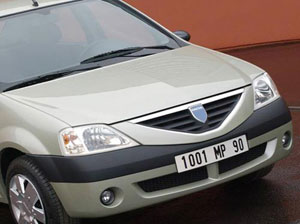Renault Dacia Logan Car in Romania
| Got 5,000 Euros? Need A New Car? Drivers across Europe are clamoring for Renault’s ultracheap, no-frills Logan Business Week – July 4, 2005 A strange thing happened when French auto maker Renault last fall rolled out the no-frills Logan, a midsize sedan was designed to sell for as little as 5,000 euros ($6,000) in emerging markets like Poland. Western buyers clamored for the car. So this June, Renault began delivering the roomy, unpretentious five-seater to France, Germany, and Spain. The pricier West European version includes a passenger-side airbag and a three-year warranty but still sells for a base price of $9,300 — about half that of the Ford Focus ($17,250) and the Volkswagen Golf ($18,264).
|
The Making of the Logan Designer Kenneth Melville explains how just how tough it is to build a $6,000 car, including some swallowing of pride
A: [Laughs] Our product-planning team did research on-site in Romania. And it’s true that Romanians use their cars for everything, including the transport of pigs. Until now, they have had small, poorly designed cars — there was a real need for a car that could transport a lot of goods. The product-planning brief was a value-for-money car with a lot of space. And it had to have the stately look of a sedan. Q: How did you go about designing a car for 5,000 euros [$6,000]? A: We had to put the cost element at the forefront of our thinking. It became the driving force behind the design. The engineers had the technical solutions [for a low-cost car], and we had to work around them to make the car attractive and modern.
A: The dashboard for example, is one injection-molded piece. That minimizes the assembly process and ensures consistency. The dashboard on a midsize Western car is composed of many pieces. We weren’t allowed to break up the dashboard with colors or special finishes. But we used the radio console to play with a paint finish. Q: What sets the Logan apart from previous attempts to build a so-called “world car”? A: Many companies tried to produce a global car on one body style that was designed for their home market. We designed a car for emerging markets from a white sheet of paper. We reduced the cost of design and development by using parts from existing models, such as the Renault Clio and [Renault] Modus and Nissan Micra. And we can ship the tooling to the countries where the Logan is produced. Q: Where else did you save money? A: The protective moldings for the body of the car — the rubber strip over the door — are the same on the left and right side of the car. In more expensive cars, they’re different. So you can use one tool instead of two, and you only have one reference in the factory. Q: Deutsche Bank’s automotive analysts figure if you sell the Logan in its base version without options for $6,000, you are losing $36 per car. But Chairman Louis Schweitzer insists the Logan will generate an operating margin of 5%. How do you resolve that contradiction? A: The Logan is like McDonald’s. It’s a low-cost object, and you have to sell high volumes to make a profit. In Russia, India, and Iran, we’re after high volumes. That’s the only way to cover the initial investment. The profit margin on each vehicle isn’t like that on a Porsche.
A: Obviously, we kept the production technology as simple as possible. In modern cars, you can apply different decorative films to the interior using a water-bath method, where a film is draped over the false wood or aluminium. It’s a high-tech solution. If you go to India, you can’t have that kind of technology, so we went for paint.
A: We went for simple shapes — it’s not a sexy car. The windshield is a simple curve. If it’s double curved, as in many cars, you get a lot of defects during the production process. The Renault Espace, for example, has a windshield that’s very complex to manufacture because you have to stretch hot glass over a huge curved form — it’s not easy.
A: We looked very closely at Tata Motors in India. From a design point of view, they’re doing interesting things. They’re trying to build more modern-looking cars. The Tata Indigo is a rival, but it’s a little more expensive than the Logan. Q: What was the toughest part of designing the Logan? A: The most challenging thing for the designers was to swallow our pride — we want things to look beautiful, or as attractive as possible. At Mercedes, I worked on the design of the SLK and the S-Class. [Letting go of that] was the hardest thing. |
|||||
 |
||||||
